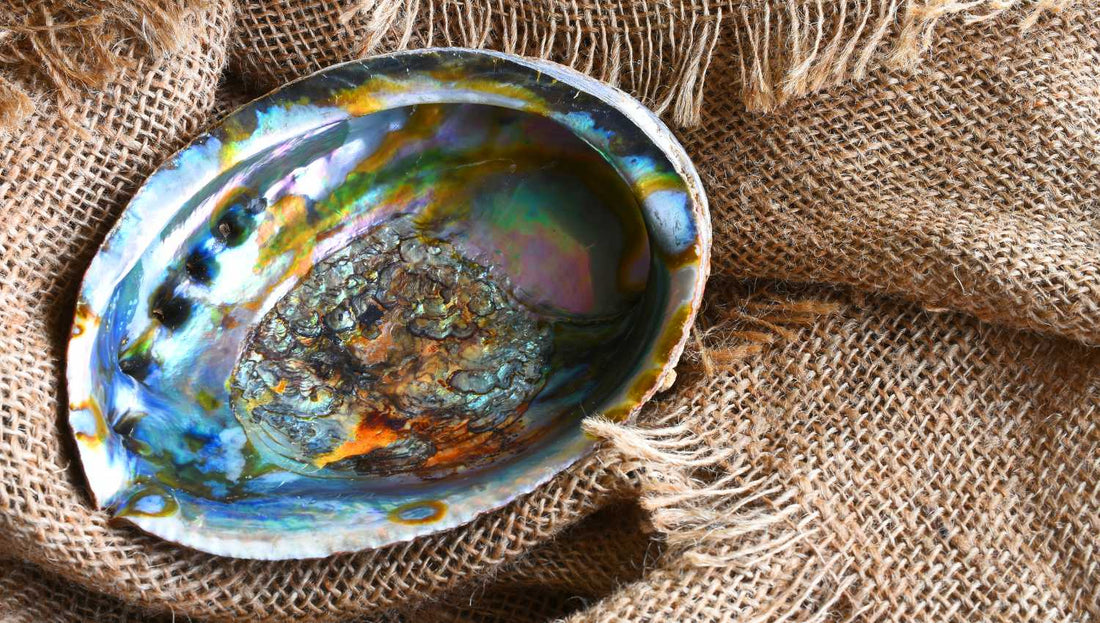
ABALONE PRESENTATION
Presentation of abalone
This unique gastropod, often nicknamed "sea ear" because of the spiral of its shell that resembles an ear, carries its shell on its back, a bit like a turtle. It moves around thanks to a large foot that takes up a large part of its shell. This organ is also prized for its flavor, whether eaten raw or cooked.
A shell with fascinating pearly reflections
Abalone is known for the splendor of its mother-of-pearl shell. This presents dazzling hues of green and blue, particularly in certain species such as:
- Haliotis rufescens (American species, Pacific coast): ochre red outer shell.
- Haliotis iris (New Zealand species): mother-of-pearl with vibrant reflections.
Abalone are appreciated both in France, where they are eaten along the coasts of Brittany, and in Asia, particularly in China and Japan, under the name of abalone.
Traditional uses of abalone
Crafts of the First Peoples
Abalone shells were used by early peoples for their mother-of-pearl. For example:
- West Coast Native Americans : wood inlays for totems or masks.
- New Zealand Maori : boat prow decoration.
Fishing and natural baits
Abalone mother-of-pearl was also used to make hooks for fishing bonito (a cousin of tuna). Its luminous reflections attracted fish, which they mistook for sardines.
Abalone pearls: rare and precious treasures

A coveted rarity
Sometimes a pearly mass forms in the abalone shell: a pearl. These pearls, rare and natural, are highly sought after today, particularly in fine jewelry.
Unique shapes
Unlike classic pearls, abalone pearls are baroque and not spherical. Due to the lack of space in the shell, they take on various shapes:
- Plates
- Lying down
- Claw shaped
Training
Pearls develop in the abalone gonad, often after the intrusion of a parasite. The abalone's pierced spiral sometimes bears witness to this process.
Spectacular colors
Abalone pearls are distinguished by their intense and shimmering colors, producing luminous effects comparable to those of peacock feathers.
Exceptional dimensions
- World record : a 469 carat (93.80 g) Haliotis rufescens pearl.
- New Zealand : Moana Natural Abalone Pearl exploits fishing quotas to discover these rare pearls.
Multiple attractions: flesh, mother-of-pearl and pearls
In addition to their pearls, abalones offer a tasty flesh and mother-of-pearl ideal for costume jewelry. These unique creations appeal to customers seeking authenticity in the face of the overproduction of cultured pearls.
Abalone in Japan: a thousand-year-old tradition
Ama Divers
The "Ama", famous Japanese divers, harvested abalone (called "awabi") while holding their breath. Immortalized in works of art, such as those of Kitagawa Utamaro or Utagawa Kunisada, they embodied the beauty and harshness of this practice traditional.
Fishing and disappearance
Historically, the Ama led an austere life, marked by extreme working conditions. Overfishing and pollution in the 1970s caused the abalone to become scarce and the activity to gradually disappear.
Kokichi Mikimoto and the Ama
Kokichi Mikimoto, a pioneer of cultured pearls, allowed some Ama to work on his farms by providing them with dignified conditions. Today, diving demonstrations are organized on Mikimoto Pearl Island to perpetuate this memory.

A precious heritage to preserve
Between tradition, art and jewelry, abalone continues to fascinate with its multiple riches: its flesh, its mother-of-pearl and its rare pearls. Preservation initiatives, such as those of Moana Natural Abalone Pearl, demonstrate the importance of protecting this unique marine treasure.
